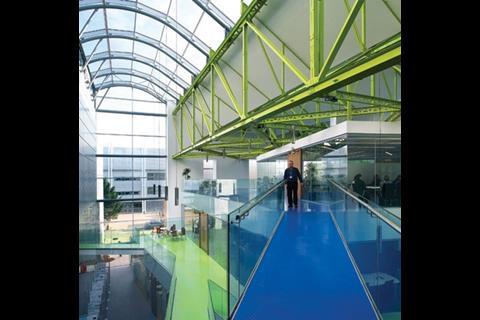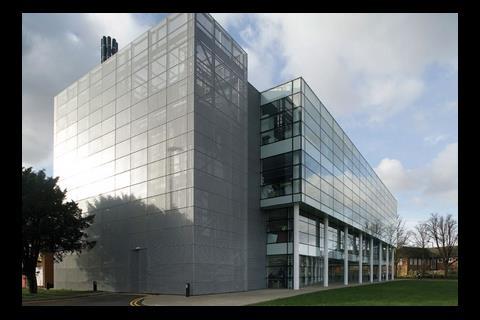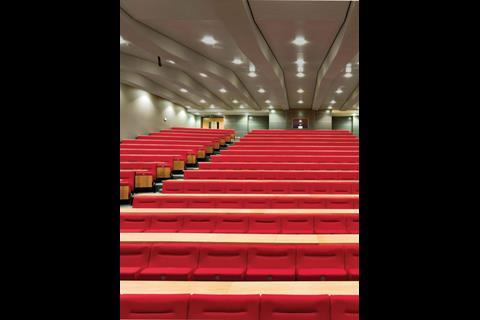Universities are vital in maintaining the UK’s place in the knowledge economy and have been major building clients over the past 10 years. How will higher education clients approach tougher times? Simon Rawlinson and Laurence Brett of Davis Langdon look at emerging trends in the sector
01 / Introduction
The higher education sector has been transformed in the past 20 years. The introduction of tuition fees may have grabbed the headlines but institutions have doubled in size to serve more than 2 million students.
As well as being world leaders in research, UK universities now serve a much wider demographic, with about 40% of the population graduating in their early 20s. Growth in some institutions has been very rapid indeed, and there are 17 universities in the UK accommodating more than 25,000 students.
Looking forward, further changes affecting the sector include the introduction of two-year foundation degrees. In addition there will be a new quality-related research assessment system that will channel a higher proportion of government research funding to the top tier of research universities.
The government’s 2009 stimulus package has brought forward more than £200m of additional expenditure on higher education projects in the UK – testament to the ambition of the sector and the number of “spade-ready” projects that universities are able to bring to market.
Against a background of record growth in student numbers, universities have enjoyed generous capital funding for buildings and infrastructure, and have been able to borrow additional funding at advantageous rates.
Central government’s capital budget, boosted by stimulus spending, will total £938m in 2009/10, and overall capital investment will be in excess of £2bn. However, tighter settlements can be anticipated, with £180m of efficiency savings from revenue spending required in 2010/11 from English universities alone, and the capital budget will fall to £488m in the same year.
Limited budgets may not necessarily result in reduced ambitions, as institutions face many challenges that require them to invest in their estates, including international competition for resources and research funds, demographic change, evolution in teaching methods and the sustainability agenda.
How they choose to manage the balance of their investment between existing and new space will have important consequences for consultants and contractors. “Spend to save” is likely to become a greater priority as universities seek to rationalise their estate and minimise running costs.
02 / The higher education sector
The role of universities has evolved to the extent that excellence in research and teaching describes only part of the place of higher education in the UK economy.
Universities drive innovation into business and public services; they also increasingly collaborate across international borders and they have an important role in promoting national and regional culture and development.
There is a broad consensus that continuing investment in higher education is vital for the UK’s international reputation and economic competitiveness.
However, investment levels are relatively low – totalling about 1.1% of GDP, compared with nearly 3% of GDP in the US, for example.
Past returns on research funding have been extremely high, and it is claimed that £600m of innovation funding has yielded returns of more than £3bn. Investment in research is being focused on science, technology, engineering and mathematics (the STEM disciplines).
However, project-related funding cannot be relied on to provide all investment in facilities and equipment. The £1.3bn of government-backed research capital investment funding allocated from 2008 to 2011 is building on previous phases of funding from the Joint Investment Framework and the Science & Research Investment Fund.
This will ensure that a substantial element of the UK’s teaching and research infrastructure is maintained at a globally competitive level, able to attract the best brains and to secure international research commissions.
Investment is not just focused on research. Widening access has also been an important priority, supported through recruitment initiatives, bursaries and the development of local centres.
As the UK looks to emerge from recession, universities will find themselves at the forefront of economic regeneration in locations as diverse as Cornwall and Manchester.
In addition to “science city” technology clusters, the government is also promoting development through the New University Challenge, which proposes the development of 20 facilities by 2014 – promoting access to resources in areas that are poorly served by existing higher education institutions.
03 / Design principles
Research by Cabe has demonstrated that university buildings have a significant role to play in supporting the recruitment, retention and performance of staff, researchers and students by differentiating the institution and providing efficient, enjoyable workspaces.
Although students are most sensitive to the range of academic and pastoral facilities on offer, such as the ready availability of sports and library buildings, staff – and in particular research students – respond more strongly to the immediate quality of their surroundings in terms of cleanliness, quality of space, aesthetics and external views.
However, the total UK university estate is large and diverse, totalling 25 million ft2 of space. It is of variable quality and as institutions compete on a national and international stage for resources and students, it is becoming ever more important to mitigate the impact of the existing estate.
Only 25% of non-residential space in the university sector has been constructed since 1980 and, significantly, more than 40% of the estate dates from the sixties and seventies.
The role of universities, methods of teaching and research and the expectations of students have evolved much faster than the buildings in which most institutions are housed. The Google Generation has very different expectations than their forebears with regards to mobile technologies and access to information through a range of media.
The educational model is evolving from one that is teacher-centred to an approach that is learner-centred. This is much more diverse with respect to sources, settings and methods of learning.
As a result established approaches to design and fit-out are under challenge, and each new-build or refurbishment project presents opportunities to innovate and enhance the effectiveness of a university.
In addition to getting the basics of scale, acoustics, ventilation, heating and light right, other areas in which a building needs to perform include:
- Flexibility to support different teaching methods – ranging from traditional lectures to peer-to-peer learning or the use of multimedia
- Adaptability to accommodating different uses and to enable easy reconfiguration. This applies to research laboratories as well as teaching and administration space
- Distinctiveness so as to characterise and differentiate the institution
- Inspiration so as to inspire academic endeavour
- Efficiency – making best use of buildings through good space planning and the imaginative use of balance space for teaching and social uses.
In their favour, higher education institutions are well placed to be able to commission good buildings for a number of reasons: their independent, self-governing status, their ability to secure project funding from other sources, including donors and funding institutions, and their development perspective as end users.
These factors should result in a well-considered brief and the commissioning of an adaptable building designed for an extended life.
04 / Flexibility and efficiency
One big challenge for higher education institutions is the effectiveness of their space planning.
Cost of space is the second largest overhead after staff, and institutions have been driving down their space use through a combination of better timetabling of rooms and the refurbishment and reconfiguration of space.
Overall space use per student fell by about 12% in five years up to 2005/06. This was achieved against a backdrop of growing requirements for more sophisticated and extensive teaching space and an expanding administration function.
Optimising space use is typically driven by the following factors:
- Maximising the proportion of usable space within any base build design
- Applying flexible working practices in office and research space, using open-plan, group work and quiet study settings to achieve best practice space allocations
- Selecting furniture that makes best use of space
- Planning space and specifying furniture to be versatile. They should potentially accommodate different activities within the timetable
- Using balance space actively as a setting for collaborative work or self study – possibly enabled by wireless networks.
The move away from cellular space will be familiar to office workers but is challenging in the academic environment, where quiet, concentrated study and group working have often had dedicated settings.
Furthermore, the speed of adoption of communication and collaboration technologies has in some cases been faster and more innovative in the sector than in the wider business world, with a growing reliance on teaching and research by means of wireless communication, multimedia and leading edge “immersive” technologies.
There are also sophisticated approaches to interior design that encourage self-policing by students and staff of potentially conflicting uses in multi-function buildings. These are being developed to facilitate effective flexible working and to respond to rapid changes in teaching.
Such an approach is particularly important in aspects of universities that operate rapidly evolving service models, such as information centres, where ways of working have to respond not only to changing technologies but also to changing expectations from their users.
Accordingly, libraries that have been focused on supporting solo book-based learning are being reconfigured as learning resource centres to support remote access, multi-source study, group learning and other approaches facilitated increasingly by digital media.
05 / Refurbishment
Not only is the sector grappling with the consequences of two decades of explosive growth and change in teaching and research methods, but it must also address the legacy of previous higher education sector expansion – particularly that which took place in the sixties and seventies.
More than 70% of the university estate consists of buildings that are 25 years old or more. The replacement cost of sixties buildings in English universities alone is estimated to be £11bn.
Because there are significant backlog repair and maintenance issues associated with many of these buildings, universities may shortly find themselves forced to make difficult replace-or-refurbish decisions in connection with a large number of their buildings.
Problems with the performance of buildings dating back to the sixties are well documented, ranging from poor environmental control, the presence of asbestos and other controversial materials and unsuitable floorplates.
A recent report called The Legacy of Sixties University Buildings, commissioned by the Association of University Directors of Estates (AUDE), sets out the scale of the problem, together with the complexity of the issues involved in determining the right investment option.
Previously, where funding has allowed replacement, institutions have often preferred to opt for a lower risk, new-build option rather than a reconfiguration and recladding scheme.
However, with scarce resources and a greater focus on sustainability, reusing elements of existing buildings is becoming increasingly attractive to clients, particularly in city-centre sites that have less value in the current market and where the massing achieved with the original might not be secured under a new planning consent.
But not all buildings are suitable for refurbishment, and constraints on ceiling heights, floor loadings, structural grids, vertical circulation and services distribution could limit the potential for reuse.
In some instances, a combination of new build and refurbishment will provide the best means of delivering a mix of general teaching accommodation and specialist technical spaces such as laboratories.
As the AUDE report emphasises, large-scale refurbishment is rarely a low-cost option and the benefits of reusing the original building are likely to be secured through several different ways.
These might include the retention of distinct building stock, faster development programmes and the mitigation of aspects of sustainability such as embodied carbon.
Looking forward, new-build projects should be designed with refurbishment and reconfiguration in mind, with floor heights, structural grids and floor loadings designed to accommodate more than one use.
06 / Sustainability
Sustainability is an important dimension of the teaching and research mission of many academic institutions and as long-term investors, university clients have been at the forefront of much innovation in building sustainability.
Universities are being challenged by the government to make a big contribution to efforts to increase sustainability through immediate action, research and support for a long-term strategy.
As budgets for development are stretched, difficult decisions between the conflicting requirements of technical capability and environmental impact will become more difficult to resolve.
Nearly 50 higher education institutions have worked with the Carbon Trust to develop carbon reduction programmes.
Looking forward, funding authorities are setting carbon emissions reduction targets in response to the implementation of the Climate Change Act, and capital allocations are increasingly tied to the achievement of sustainability targets.
In England, the current target is the finalisation of sustainable development strategies. Thereafter targets for BREEAM accreditation and further carbon reduction will be introduced as clients work towards the 2019 zero net carbon target. Funding bodies in Scotland and Wales already mandate minimum levels of BREEAM.
In recognition of the unique nature of many university buildings, the higher education sector has its own BREEAM scheme, which covers 78 dimensions of performance. This includes issues such as student/staff consultation, the use of the building as a learning resource, ease of maintenance and whole-life costing, as well as specific technical requirements related to laboratories and cold storage.
A growing number of clients are aiming for the “excellent” rating.
Beyond major capital works programmes, schemes such as the Revolving Green Fund are supporting greenhouse gas reduction efforts at an institution-wide and small project scale.
07 / Procurement
Universities are often significant construction clients in their market, and have been well positioned to take advantage of the benefits of partnering and frameworks over recent years.
However, in a market where prices are falling rapidly and framework rates may have been set at the peak of the boom, clients have a dilemma in balancing different dimensions of best value.
Frameworks have facilitated the development of long-term relationships with contractors and consultants. This in turn has supported the effective management of wider programmes of work and investment in collaborative approaches to procurement, such as two-stage develop and construct.
Where the client and supply chain have had clearly shared objectives and both recognise the basis on which added value is being delivered through the framework, clearly there is benefit to both parties.
In particular, there is evidence that certainty of delivery has improved on projects procured using frameworks – often as a result of greater input from the contractor into the development and de-risking of the design.
However, not all projects procured with frameworks have succeeded in being able to deliver the level of expected value to clients. For many projects it is the challenge of affordability that is driving clients to reconsider competitive tendering – typically using a single-stage route to secure a bid for a design-and-build contract.
Assuming the brief is signed off and the design is completed and co-ordinated to the appropriate level of detail for the contract, clients should be able to secure competitive prices while allocating a fair transfer of risk.
However, clients that seek lowest price bids need to be much more disciplined during construction if the expected outturn price is to be obtained. Retaining the services of contractors and consultants on a framework will not insulate a client from the risks of the current market. So although a commitment to the framework should secure long-term benefits of contractor loyalty, it is important that the client also secures a fair share of the buying gain that is likely to be obtained in the present market.
08 / Cost model
The cost breakdown is based on a new-build standalone teaching and research facility that includes workshop and laboratory accommodation.
The gross internal floor area is 4,500m2 built over two storeys.
The building is constructed in reinforced concrete with a combination of facade materials including render, timber rainscreen and curtain walling with automatically controlled opening lights.
The building is designed to meet the BREEAM “excellent” standard and in addition to featuring a carefully selected range of low-impact materials, the scheme includes a ground-source heat pump.
Rates in the model refer to the second quarter of 2009 and are based on a two-stage develop-and-construct model of procurement at a location in the south-east of England.
The overall cost is inclusive of preliminaries, fixed furniture and design reserve.
Other project costs, including external works and services, site infrastructure, professional fees, IT installation and VAT, are excluded and would typically add at least 35% to the overall cost of the project.
Rates in the model may need to be adjusted to take acount of specification, site conditions, procurement route, programme and location.
Details of location factors are provided in the table.
Downloads
09 / University cost breakdown
Other, Size 0 kb






























No comments yet